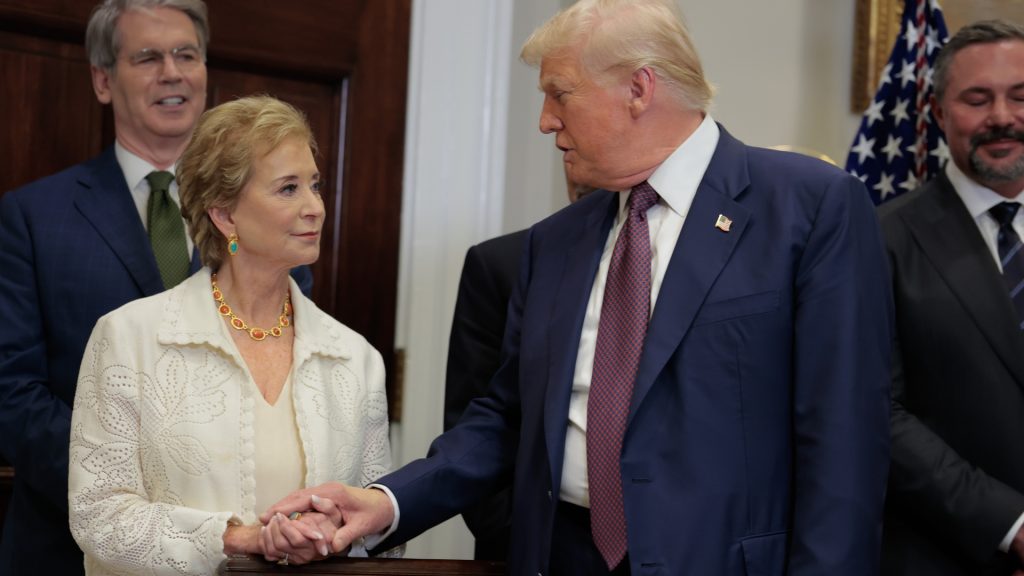How Trump’s split of the Dept. of Ed will affect your child’s classroom

The Trump administration announced details on its plan to dismantle the Department of Education. While the administration can’t fully close the department, its plan involves breaking it up from within.
Dismantling the Dept. of Ed
The plan involved six new interagency agreements between four different agencies to break up the Education Department.
Here’s a look at how those agreements will split up the department.
Elementary and secondary education
The Department of Education and the Department of Labor will share responsibility. The Department of Labor will take a larger role in administering K‑12 programs, aiming to better align them with workforce and college pathways.
Postsecondary education
The Department of Education and the Department of Labor will also partner on higher education. The Department of Labor will oversee most postsecondary education grants.
Indian education
The Department of Education and the Department of the Interior will collaborate. The Department of the Interior will expand its role in administering Native American education programs across all levels.
Foreign medical accreditation
The Department of Education and the Department of Health and Human Services will partner. Health and Human Services staff will take over evaluating accreditation standards for foreign medical schools.
Child care access for parents in school
The Department of Education and the Department of Health and Human Services will continue their partnership. Health and Human Services already manages on‑campus child care support for college parents and will take on an even bigger role.
International education and foreign language studies
The Department of Education and the Department of State will streamline programs under the Fulbright program, the government’s flagship international educational exchange initiative.
“Cutting through layers of red tape in Washington is one essential piece of our final mission,” Education Secretary Linda McMahon said in a statement. “As we partner with these agencies to improve federal programs, we will continue to gather best practices in each state through our 50-state tour, empower local leaders in K-12 education, restore excellence to higher education, and work with Congress to codify these reforms.”
Federal student loan and grant programs will not be impacted by the department’s agreements with other agencies at this point.
Complete removal of the department
These moves from McMahon and her department come as part of a campaign promise from President Donald Trump to completely close the department, which began in 1979 under former President Jimmy Carter.
“We were coming out of a lot of changes with educational equity and the Brown [vs the Board of Education] decision,” Adrienne Dixson, head of the Department of Education Policy Studies at Penn State University, told Straight Arrow News. “Although it was decided in 1954, the full implementation of Brown didn’t really happen until much later. And into the ‘70s, we were addressing racial segregation through bussing. And so, the Department of Education wasn’t a standalone. It was a part of a bigger agency.”
The basic goal was to give minorities equal access to education. In an executive order in March, Trump said the department is failing students, teachers and families.
However, formally closing the department would require an act of Congress, and the administration doesn’t have the support to do that.
Why shutter the Education Department?
“What they want to do in closing the department is to return education to the states, right?” Kevin Welner, professor emeritus at the School of Education at the University of Colorado, Boulder and director of the National Education Policy Center, told SAN. “That’s the rhetoric that we hear. But this doesn’t do that. It moves the staff from one place to another within D.C., but all the roles continue.”
The Trump administration believes moving these roles to other agencies will streamline certain processes.
“I think it is a reasonable and promising move to shrink the footprint of the federal Department of Education,” Rick Hess, director of Education Policy Studies at the American Enterprise Institute, a conservative think tank, told SAN. “As with any reorganization like this, the proof is ultimately in the pudding, and it’ll depend on how thoughtfully and how carefully it’s managed.”
While McMahon even mentioned returning education to the states in the press release, experts SAN spoke with expressed criticism of that rhetoric. States already run public schools.
“Functionally, what they’re trying to do is they’re just trying to remove all federal influence from public schools,” Michael Hansen, senior fellow at the Brown Center on Education Policy at the Brookings Institution, a nonprofit think tank, told SAN. “Because, based on their viewpoint, any influence from the federal government is just wasteful spending. It is not conducive to improving student outcomes, in their view.”
That is a very clear contradiction from earlier moves from the administration targeting higher education over what’s being taught on college campuses.
“There’s one part of this administration which thinks it’s really important to reduce the visible federal role in education, especially in K-12,” Hess said. “At the same time, there’s another faction in the administration which sees the federal government as playing a crucial role in pushing back on a lot of the pathologies that have grown up on campus.”
While they may not be able to completely shut down the department, these moves do work as a message.
“Some of this is simply about trying to make a bigger statement about the direction going forward,” Hess said.
Concerns over the latest moves
Tuesday’s announcement from the Trump administration could face pushback from Democrats in Washington.
“If you starve it for resources, that’s not necessarily illegal,” Dixson said.
There is some legal pushback already, though, particularly in McMahon v. New York, a case in which nearly two dozen states sued to block the firings of many Education Department employees earlier this year. Welner, who’s also a lawyer, said the courts have been clear in other areas that skirting a law with technicalities should not stand.
“The Department of Education shouldn’t be able to ignore the spirit of the laws that Congress passed by removing the programs and the duties from the Department of Education,” Welner said.
Other than the legal issues, what are the concerns of dismantling this department?
“Most importantly, probably is the research, the knowledge,” Dixson said. “As a researcher, obviously, I care about how we develop and maintain a kind of broader understanding about teaching and learning and curriculum. And so, the federal government has always been an important investor in our knowledge.”
Dixson said the Department of Education funds most of their research.
“We lose on knowledge creation, and I don’t know how we see ourselves as a leader in the world if we disinvest in research, particularly around research and learning and education,” Dixson said.
Another concern is over efficiency.
“If I’m understanding this correctly, it looks like the staff in one department, for example, the Department of Labor, will be managed by supervisors in another department, the Department of Education,” Welner said. “Which sounds extremely inefficient.”
The other issue with that is state-level education leaders losing certain connections.
“They know the process of working with the Department of Education to get questions answered, to deal with concerns raised by the department to get funding,” Welner said. “They don’t have those relationships or that experience with the Department of Labor.”
How will it impact students?
That question is a little more complex to answer. Some felt it could have a significant impact.
“This serves to the detriment of students and educators in the schools, in our public schools,” Hansen said.
Others weren’t sure.
“On the policy side, it’s a little unclear what the impacts would be,” Welner said.
And others didn’t expect much impact.
“In terms of direct impact on students in K-12 or college or the education’s educators, there’s very little,” Hess said.
The experts SAN spoke with said the biggest impacts won’t fall on students.
“The biggest impact is going to be on folks who manage college finances or who work at state departments of education,” Hess said.
Despite all these moves being made, the absence of the complete closure of the department means this could be far from over.
“Certainly, an administration headed by a Democratic president would reverse this,” Welner said. “So it feels from that perspective, from a policy perspective, it feels just like theater, highly disruptive theater, but still theater.”
The post How Trump’s split of the Dept. of Ed will affect your child’s classroom appeared first on Straight Arrow News.





